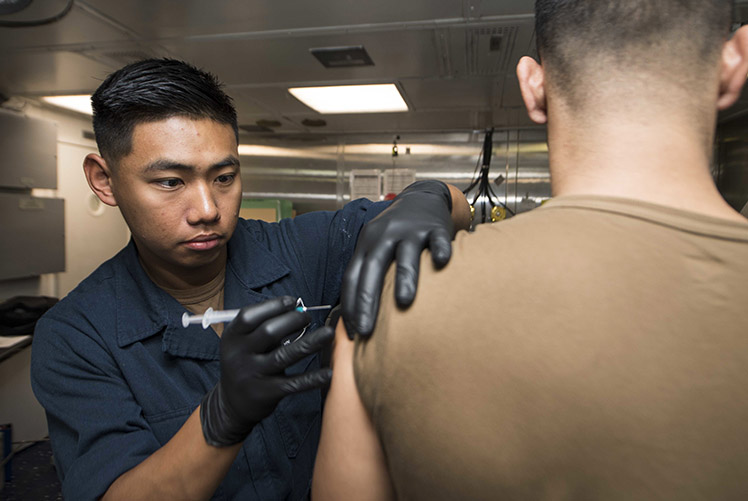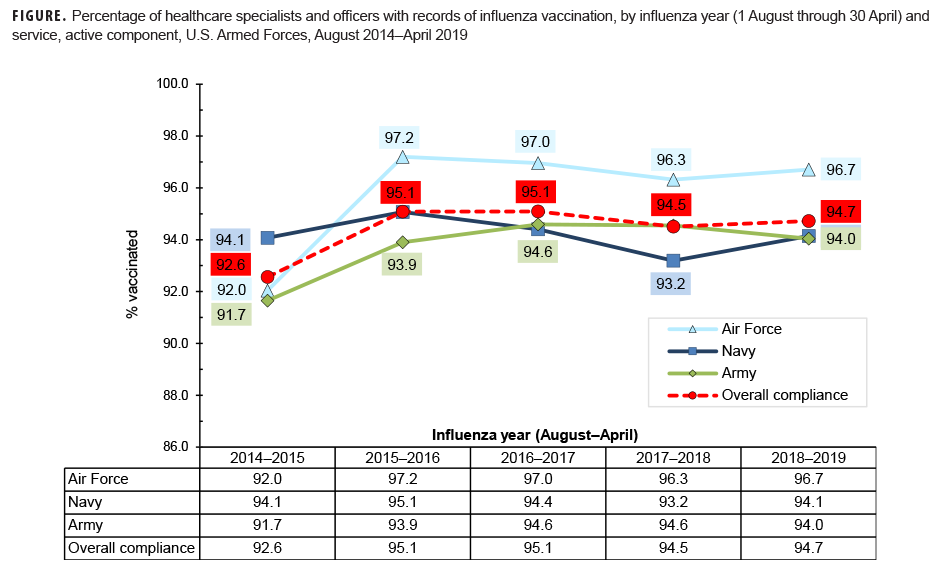Surveillance Snapshot: Influenza Immunization Among U.S. Armed Forces Healthcare Workers, Aug. 2014–April 2019
 181129-N-GR847-3000
ARABIAN GULF (Nov. 29, 2018) Hospitalman Jay Meadows, from Weaver, Ala., administers an influenza vaccine to a Sailor during a regularly scheduled deployment of the Essex Amphibious Ready Group (ARG) and 13th Marine Expeditionary Unit (MEU). The Essex ARG/13th MEU is flexible and persistent Navy-Marine Corps team deployed to the U.S. 5th Fleet area of operations in support of naval operations to ensure maritime stability and security in the Central Region, connecting to the Mediterranean and the Pacific through the western Indian Ocean and three strategic choke points. (U.S. Navy photo by Mass Communication Specialist 3rd Class Reymundo A. Villegas III)
181129-N-GR847-3000
ARABIAN GULF (Nov. 29, 2018) Hospitalman Jay Meadows, from Weaver, Ala., administers an influenza vaccine to a Sailor during a regularly scheduled deployment of the Essex Amphibious Ready Group (ARG) and 13th Marine Expeditionary Unit (MEU). The Essex ARG/13th MEU is flexible and persistent Navy-Marine Corps team deployed to the U.S. 5th Fleet area of operations in support of naval operations to ensure maritime stability and security in the Central Region, connecting to the Mediterranean and the Pacific through the western Indian Ocean and three strategic choke points. (U.S. Navy photo by Mass Communication Specialist 3rd Class Reymundo A. Villegas III)
The U.S. Advisory Committee on Immunization Practices recommends that all health care personnel be vaccinated against influenza to protect themselves and their patients.1 The Joint Commission's standard on infection control emphasizes that individuals who are infected with influenza virus are contagious to others before any signs or symptoms appear. The Joint Commission requires that health care organizations have influenza vaccination programs for practitioners and staff and that they work toward the goal of 90% receipt of influenza vaccine. Within the Department of Defense, seasonal influenza immunization is mandatory for all uniformed personnel and for health care personnel who provide direct patient care and is recommended for all others (excluding those who are medically exempt).2–4
This snapshot covers a 5-year surveillance period (Aug. 2014–April 2019) and presents the documented percentage compliance with the influenza immunization requirement among active component health care personnel of the Army, Navy, and Air Force. During the 2018–2019 influenza season, each of the 3 services had compliance rates of 94.0% or higher among health care personnel (Figure). For all services together, the compliance rate was 94.7%, very similar to the rate from the previous year.
References
- Centers for Disease Control and Prevention. Immunization of health-care personnel: recommendations of the Advisory Committee on Immunization Practices (ACIP). MMWR Recomm Rep. 2011;60(RR-7):1–45.
- Headquarters, Departments of the Army, the Navy, the Air Force, and the Coast Guard. Army Regulation 40-562, BUMEDINST 6230.15B, AFI 48-110_IP, CG COMDTINST M6230.4G. Medical Services: Immunizations and Chemoprophylaxis for the Prevention of Infectious Diseases. 7 Oct. 2013.
- Assistant Secretary of Defense for Health Affairs. Policy for Mandatory Seasonal Influenza Immunization for Civilian Health Care Personnel Who Provide Direct Patient Care in Department of Defense Military Treatment Facilities. Health Affairs Policy 08-005. 4 April 2008.
- Assistant Secretary of Defense for Health Affairs. Addition of Pandemic Influenza Vaccine or Novel Influenza Vaccine to the Policy for Mandatory Seasonal Influenza Immunization for Civilian Health Care Personnel Who Provide Direct Patient Care in Department of Defense Military Treatment Facilities. Health Affairs Policy 11-010. 28 July 2011.

You also may be interested in...
Article
Nov 1, 2022
Mental health is a significant concern within the U.S. military, and service members are at substantial risk for developing an array of mental health conditions including anxiety, depression, stress/adjustment issues, and sleep-related disorders.
Article
Oct 1, 2022
This report summarizes the annual prevalence of permanent sterilization, as well as use of long- and short-acting reversible contraceptives (LARCs and SARCs, respectively), contraceptive counseling services, and use of emergency contraceptives from 2017 through 2021 among active component U.S. service women.
Article
Oct 1, 2022
This study reports updated numbers and incidence rates of hepatitis C virus (HCV) infection among active component members of the U.S. military using a revised case definition during a 10-year surveillance period between 2011 and 2020.
Article
Oct 1, 2022
Immunization Among U.S. Armed Forces Healthcare Workers
Article
Sep 1, 2022
The validity of military hepatitis C virus (HCV) surveillance data is uncertain due to the potential for misclassification introduced when using administrative databases for surveillance purposes. The objectives of this study were to assess the validity of the surveillance case definition used by the Medical Surveillance Monthly Report (MSMR) for HCV ...
Article
Sep 1, 2022
Menstrual suppression allows for the control or complete suppression of menstrual periods through hormonal contraceptive methods. In addition to preventing pregnancy, suppression can alleviate medical conditions and symptoms associated with menstruation such as iron deficiency anemia,1 eliminate logistical hygiene-related challenges, and improve ...
Article
Sep 1, 2022
We read with interest the brief report regarding the prevalence of Hepatitis C Virus (HCV) infection in basic military trainee blood donors by Kasper and colleagues in the November 2021 issue of the Medical Surveillance Monthly Report (MSMR),1 an update of a previous similar report
Article
Sep 1, 2022
This report provides an update through June 2022 of routine screening results for antibodies to the human immunodeficiency virus (HIV) among members of the active and reserve components of the U.S. Armed Forces. During the full 5 and 1/2-year surveillance period, the HIV seropositivity rates for active component service members were 0.21 positives per ...
Article
Aug 1, 2022
Musculoskeletal (MSK) injuries are costly and the leading cause of medical visits and disability in the U.S. military.1,2 Within training environments, MSK injuries may lead to a loss of training, deferment to a future class, or voluntary disenrollment from a training pipeline, all of which are impediments to maintaining full levels of manpower and ...
Article
Aug 1, 2022
The post-9/11 U.S. military conflicts in Iraq and Afghanistan lasted over a decade and yielded the most combat casualties since the Vietnam War. While patient survivability increased to the highest level in history, a changing epidemiology of combat injuries emerged whereby focus shifted to addressing an array of long-term sequelae, including ...
Article
Aug 1, 2022
During calendar year 2019, the estimated prevalence of myopia, hyperopia, and astigmatism were 17.5%, 2.1%, and 11.2% in the active component of the U.S. Armed Forces and 10.1%, 1.2%, and 6.1% of the U.S. Coast Guard, respectively.
Article
Jul 1, 2022
Respiratory pathogens, such as influenza and adenovirus, have been the main focus of the Department of Defense Global Respiratory Pathogen Surveillance Program (DoDGRPSP) since 1976.1. However, DoDGRPSP also began focusing on SARS-CoV-2 when COVID-19 was declared a pandemic illness in early March 2020.2. Following this declaration, the DOD quickly ...
Article
Jul 1, 2022
Lesbian, gay, and bisexual (LGB) individuals are at a particularly high risk for suicidal behavior in the general population of the United States. This study aims to determine if there are differences in the frequency of lifetime suicide ideation and suicide attempts between heterosexual, lesbian/gay, and bisexual service members in the active ...
Article
Jul 1, 2022
This report describes SARS-CoV-2 genomic surveillance conducted by the Department of Defense (DOD) Global Emerging Infections Surveillance Branch and the Next-Generation Sequencing and Bioinformatics Consortium (NGSBC) in response to the COVID-19 pandemic. Samples and sequence data were from SARS-CoV-2 infections occurring among Military Health System ...
Article
Jul 1, 2022
The Armed Forces Health Surveillance Division, as part of its surveillance mission, periodically conducts studies of cancer incidence among U.S. military service members. However, service members are likely lost to follow-up from the Department of Defense cancer registry and Military Health System data sets after leaving service and during periods of ...
You are leaving Health.mil
The appearance of hyperlinks does not constitute endorsement by the Department of Defense of non-U.S. Government sites or the information, products, or services contained therein. Although the Defense Health Agency may or may not use these sites as additional distribution channels for Department of Defense information, it does not exercise editorial control over all of the information that you may find at these locations. Such links are provided consistent with the stated purpose of this website.
You are leaving Health.mil
View the external links disclaimer.
Last Updated: July 11, 2023